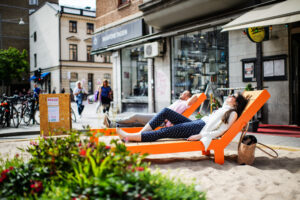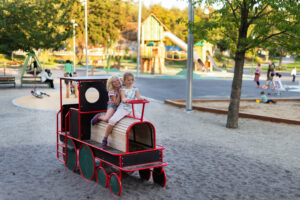Placemaking is an approach to urban planning that, at its core, focuses on the needs and experiences of the inhabitants. By transforming unutilized space and making citizens a part of the planning process, cities can become a place of well-being, togetherness, and inclusion.
Placemaking is a multi-faceted approach to the planning, design, and management of public spaces. It is both a process and a philosophy that encourages the creation of relationships between people and places.

Image by Simon Paulin/imagebank.sweden.se
Good placemaking has the potential to transform underutilized spaces into vibrant places through urban design interventions and create conditions that enhance the experience at the pedestrian level.
Placemaking is based on a co-creation between different actors, particularly the community members who will be the intended users of a place. This way, community participation is a key element for placemaking, as it recognizes that residents are likely to have valuable insights into how the space does – or should – function.
This involvement fosters the creation of strong relationships between people and places, having a positive impact on strengthening local identity. People who feel a deep connection to a place tend to perceive it as safer and to get involved in its care.
Designed Living Environment
In May 2018, a unique decision was taken in the Swedish Parliament. Sweden became one of the few countries in the world to adopt a comprehensive policy for what is known as Designed Living Environment.
Designed Living Environment concerns everything around us: residential buildings, schools and hospitals, but also public spaces such as parks, streets, and squares. This concept recognizes that the way spaces are shaped influences our daily lives. Indeed, the benefits of architecture and urban design are not just confined to the surface: a square is much more than an open space, just as the street network in a city not only controls how traffic runs.
In other words, this approach is based on the premise that architecture and design should contribute to a sustainable society that puts people’s well-being at the centre, and where everyone is able to influence the common environment.
Civil dialogue & Cultural identity
Over the last decades, citizen participation has become increasingly common in urban planning processes in Sweden. By letting citizens in at an early stage, before the formal planning process has begun and decisions are made, municipalities can capture important issues and increase the quality of the plan to reflect local needs. This may include, for example, how people use an area and what ecosystem services they use and require.
Citizen dialogue is crucial to capture the broad range of perspectives of the members of a community, involving people from different backgrounds, ages, tastes, and experiences, as well as their expectations for their future.
Some approaches like Cultural Planning seek to make visible the cultural qualities of a place, from the tangible to the intangible cultural resources that give a place a sense of identity, such as habits and traditions. Cultural Planning focuses on developing a plan where local resources take center stage from the beginning, not just added at the end. It requires, above all, a strong understanding of the community it is directed to. The Swedish Association of Local Authorities and Regions has developed a citizen dialogue guide to provide support.
The child perspective: a new element in urban planning

Image by Ulf Lundin/imagebank.sweden.se
Having a people-centered approach means that it is also important to consider children and young people’s perspectives in creating urban environments. This way, planning can facilitate the conditions that make places safe, comfortable, fun, and inclusive for them.
Several municipalities in Sweden have developed methods and tools to include the perspective of children and young people in the planning process to identify their needs and hopes for the future. This step is necessary to promote child-friendly planning and meet the goals of a socially sustainable city.